[English] 日本語
 Yorodumi
Yorodumi- PDB-4e0x: Crystal structure of the kainate receptor GluK1 ligand-binding do... -
+ Open data
Open data
- Basic information
Basic information
| Entry | Database: PDB / ID: 4e0x | ||||||
|---|---|---|---|---|---|---|---|
| Title | Crystal structure of the kainate receptor GluK1 ligand-binding domain in complex with kainate in the absence of glycerol | ||||||
 Components Components | Glutamate receptor, ionotropic kainate 1 | ||||||
 Keywords Keywords | MEMBRANE PROTEIN / ionotropic glutamate receptor / GluK1 / ligand-binding domain / agonist | ||||||
| Function / homology |  Function and homology information Function and homology informationnegative regulation of synaptic transmission, GABAergic / gamma-aminobutyric acid secretion / L-glutamate transmembrane transporter activity / positive regulation of gamma-aminobutyric acid secretion / Activation of Na-permeable kainate receptors / kainate selective glutamate receptor complex / Activation of Ca-permeable Kainate Receptor / regulation of short-term neuronal synaptic plasticity / negative regulation of synaptic transmission, glutamatergic / glutamate binding ...negative regulation of synaptic transmission, GABAergic / gamma-aminobutyric acid secretion / L-glutamate transmembrane transporter activity / positive regulation of gamma-aminobutyric acid secretion / Activation of Na-permeable kainate receptors / kainate selective glutamate receptor complex / Activation of Ca-permeable Kainate Receptor / regulation of short-term neuronal synaptic plasticity / negative regulation of synaptic transmission, glutamatergic / glutamate binding / inhibitory postsynaptic potential / synaptic transmission, GABAergic / adult behavior / behavioral response to pain / kainate selective glutamate receptor activity / modulation of excitatory postsynaptic potential / extracellularly glutamate-gated ion channel activity / ionotropic glutamate receptor complex / membrane depolarization / glutamate-gated receptor activity / glutamate-gated calcium ion channel activity / ligand-gated monoatomic ion channel activity involved in regulation of presynaptic membrane potential / presynaptic modulation of chemical synaptic transmission / ionotropic glutamate receptor signaling pathway / SNARE binding / positive regulation of synaptic transmission, GABAergic / regulation of membrane potential / excitatory postsynaptic potential / transmitter-gated monoatomic ion channel activity involved in regulation of postsynaptic membrane potential / synaptic transmission, glutamatergic / establishment of localization in cell / postsynaptic density membrane / modulation of chemical synaptic transmission / regulation of synaptic plasticity / terminal bouton / nervous system development / presynaptic membrane / scaffold protein binding / chemical synaptic transmission / postsynaptic membrane / receptor complex / postsynaptic density / neuronal cell body / dendrite / synapse / glutamatergic synapse / identical protein binding / membrane / plasma membrane Similarity search - Function | ||||||
| Biological species |  | ||||||
| Method |  X-RAY DIFFRACTION / X-RAY DIFFRACTION /  SYNCHROTRON / SYNCHROTRON /  MOLECULAR REPLACEMENT / Resolution: 2 Å MOLECULAR REPLACEMENT / Resolution: 2 Å | ||||||
 Authors Authors | Frydenvang, K. / Kastrup, J.S. | ||||||
 Citation Citation |  Journal: Neurochem Int / Year: 2012 Journal: Neurochem Int / Year: 2012Title: Kainate induces various domain closures in AMPA and kainate receptors. Authors: Venskutonyte, R. / Frydenvang, K. / Hald, H. / Rabassa, A.C. / Gajhede, M. / Ahring, P.K. / Kastrup, J.S. #1:  Journal: FEBS Lett. / Year: 2005 Journal: FEBS Lett. / Year: 2005Title: Crystal structure of the kainate receptor GluR5 ligand-binding core in complex with (S)-glutamate Authors: Naur, P. / Vestergaard, B. / Skov, L.K. / Egebjerg, J. / Gajhede, M. / Kastrup, J.S. | ||||||
| History |
|
- Structure visualization
Structure visualization
| Structure viewer | Molecule:  Molmil Molmil Jmol/JSmol Jmol/JSmol |
|---|
- Downloads & links
Downloads & links
- Download
Download
| PDBx/mmCIF format |  4e0x.cif.gz 4e0x.cif.gz | 125.7 KB | Display |  PDBx/mmCIF format PDBx/mmCIF format |
|---|---|---|---|---|
| PDB format |  pdb4e0x.ent.gz pdb4e0x.ent.gz | 97.3 KB | Display |  PDB format PDB format |
| PDBx/mmJSON format |  4e0x.json.gz 4e0x.json.gz | Tree view |  PDBx/mmJSON format PDBx/mmJSON format | |
| Others |  Other downloads Other downloads |
-Validation report
| Summary document |  4e0x_validation.pdf.gz 4e0x_validation.pdf.gz | 467.5 KB | Display |  wwPDB validaton report wwPDB validaton report |
|---|---|---|---|---|
| Full document |  4e0x_full_validation.pdf.gz 4e0x_full_validation.pdf.gz | 470.6 KB | Display | |
| Data in XML |  4e0x_validation.xml.gz 4e0x_validation.xml.gz | 24.9 KB | Display | |
| Data in CIF |  4e0x_validation.cif.gz 4e0x_validation.cif.gz | 36.7 KB | Display | |
| Arichive directory |  https://data.pdbj.org/pub/pdb/validation_reports/e0/4e0x https://data.pdbj.org/pub/pdb/validation_reports/e0/4e0x ftp://data.pdbj.org/pub/pdb/validation_reports/e0/4e0x ftp://data.pdbj.org/pub/pdb/validation_reports/e0/4e0x | HTTPS FTP |
-Related structure data
| Related structure data |  4e0wC  3c32S S: Starting model for refinement C: citing same article ( |
|---|---|
| Similar structure data |
- Links
Links
- Assembly
Assembly
| Deposited unit | 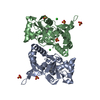
| ||||||||
|---|---|---|---|---|---|---|---|---|---|
| 1 | 
| ||||||||
| 2 |
| ||||||||
| Unit cell |
| ||||||||
| Details | A complete tetrameric multimer representing the known biologically significant oligomerization state of the molecule cannot be generated by symmetry within the crystal. |
- Components
Components
| #1: Protein | Mass: 29108.453 Da / Num. of mol.: 2 Source method: isolated from a genetically manipulated source Source: (gene. exp.)   #2: Chemical | #3: Chemical | ChemComp-SO4 / #4: Chemical | #5: Water | ChemComp-HOH / | Has protein modification | Y | Sequence details | NATIVE GLUK1 IS A MEMBRANE PROTEIN. THE PROTEIN CRYSTALLIZED IS THE EXTRACELLULAR LIGAND-BINDING ...NATIVE GLUK1 IS A MEMBRANE PROTEIN. THE PROTEIN CRYSTALLIZ | |
|---|
-Experimental details
-Experiment
| Experiment | Method:  X-RAY DIFFRACTION / Number of used crystals: 1 X-RAY DIFFRACTION / Number of used crystals: 1 |
|---|
- Sample preparation
Sample preparation
| Crystal | Density Matthews: 2.35 Å3/Da / Density % sol: 47.7 % |
|---|---|
| Crystal grow | Temperature: 280 K / Method: vapor diffusion, hanging drop / pH: 6.5 Details: 20% PEG4000, 0.35M lithium sulfate, 0.1M sodium cacodylate pH 6.5, VAPOR DIFFUSION, HANGING DROP, temperature 280K |
-Data collection
| Diffraction | Mean temperature: 110 K | ||||||||||||||||||||||||||||||||||||||||||||||||||||||||||||||||||||||||||||||||||||||||
|---|---|---|---|---|---|---|---|---|---|---|---|---|---|---|---|---|---|---|---|---|---|---|---|---|---|---|---|---|---|---|---|---|---|---|---|---|---|---|---|---|---|---|---|---|---|---|---|---|---|---|---|---|---|---|---|---|---|---|---|---|---|---|---|---|---|---|---|---|---|---|---|---|---|---|---|---|---|---|---|---|---|---|---|---|---|---|---|---|---|
| Diffraction source | Source:  SYNCHROTRON / Site: SYNCHROTRON / Site:  MAX II MAX II  / Beamline: I911-3 / Wavelength: 1 Å / Beamline: I911-3 / Wavelength: 1 Å | ||||||||||||||||||||||||||||||||||||||||||||||||||||||||||||||||||||||||||||||||||||||||
| Detector | Type: MARMOSAIC 225 mm CCD / Detector: CCD / Date: Apr 15, 2011 | ||||||||||||||||||||||||||||||||||||||||||||||||||||||||||||||||||||||||||||||||||||||||
| Radiation | Protocol: SINGLE WAVELENGTH / Monochromatic (M) / Laue (L): M / Scattering type: x-ray | ||||||||||||||||||||||||||||||||||||||||||||||||||||||||||||||||||||||||||||||||||||||||
| Radiation wavelength | Wavelength: 1 Å / Relative weight: 1 | ||||||||||||||||||||||||||||||||||||||||||||||||||||||||||||||||||||||||||||||||||||||||
| Reflection | Resolution: 2→29.513 Å / Num. all: 38773 / Num. obs: 38773 / % possible obs: 100 % / Redundancy: 6.4 % / Rsym value: 0.072 / Net I/σ(I): 9.2 | ||||||||||||||||||||||||||||||||||||||||||||||||||||||||||||||||||||||||||||||||||||||||
| Reflection shell | Diffraction-ID: 1
|
- Processing
Processing
| Software |
| |||||||||||||||||||||||||||||||||||||||||||||||||||||||||||||||||||||||||||||||||||||||||||||||||||||||||
|---|---|---|---|---|---|---|---|---|---|---|---|---|---|---|---|---|---|---|---|---|---|---|---|---|---|---|---|---|---|---|---|---|---|---|---|---|---|---|---|---|---|---|---|---|---|---|---|---|---|---|---|---|---|---|---|---|---|---|---|---|---|---|---|---|---|---|---|---|---|---|---|---|---|---|---|---|---|---|---|---|---|---|---|---|---|---|---|---|---|---|---|---|---|---|---|---|---|---|---|---|---|---|---|---|---|---|
| Refinement | Method to determine structure:  MOLECULAR REPLACEMENT MOLECULAR REPLACEMENTStarting model: PDB ENTRY 3C32 Resolution: 2→29.513 Å / Occupancy max: 1 / Occupancy min: 0.4 / FOM work R set: 0.8695 / SU ML: 0.51 / Isotropic thermal model: isotropic / Cross valid method: THROUGHOUT / σ(F): 1.4 / Phase error: 19.55 / Stereochemistry target values: ML Details: Residues 1-3 (GAN) in chain A and B, as well as residues 253-257 (GNGCP) in chain A could not be located in the electron density map
| |||||||||||||||||||||||||||||||||||||||||||||||||||||||||||||||||||||||||||||||||||||||||||||||||||||||||
| Solvent computation | Shrinkage radii: 0.9 Å / VDW probe radii: 1.11 Å / Solvent model: FLAT BULK SOLVENT MODEL / Bsol: 30.991 Å2 / ksol: 0.343 e/Å3 | |||||||||||||||||||||||||||||||||||||||||||||||||||||||||||||||||||||||||||||||||||||||||||||||||||||||||
| Displacement parameters | Biso max: 93.45 Å2 / Biso mean: 25.8507 Å2 / Biso min: 10.86 Å2
| |||||||||||||||||||||||||||||||||||||||||||||||||||||||||||||||||||||||||||||||||||||||||||||||||||||||||
| Refinement step | Cycle: LAST / Resolution: 2→29.513 Å
| |||||||||||||||||||||||||||||||||||||||||||||||||||||||||||||||||||||||||||||||||||||||||||||||||||||||||
| Refine LS restraints |
| |||||||||||||||||||||||||||||||||||||||||||||||||||||||||||||||||||||||||||||||||||||||||||||||||||||||||
| LS refinement shell | Refine-ID: X-RAY DIFFRACTION / Total num. of bins used: 14 / % reflection obs: 100 %
|
 Movie
Movie Controller
Controller






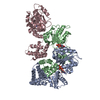

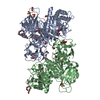
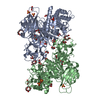


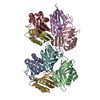
 PDBj
PDBj








